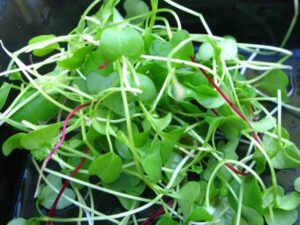How to Grow Organic Vegetables in Less Than 60 Days

Spring has sprung and you know what that means – it’s time to get in the garden and start digging! I’m sure you’re similar to me and can’t wait to get your seeds planted. Once you plant, though, there’s that terrible waiting period. How long does it take peppers to grow, anyway? (The answer is a long time if you want to put them in your salad tomorrow.) And if you’re a newbie to the gardening scene, you may even be wondering how to grow organic vegetables in general.
Luckily, there are some scrumptious vegetable varieties that grow incredibly fast. If you plant the following organic veggies now, they could be ready to grace your plate by early June. Also: If you’re unsure about how to grow organic vegetables, we’ve given you some information to get you going. Score!
How to grow organic vegetables in a 30-day growing period
Microgreens, such as pea shoots, sunflowers and beet greens, will sprout in fewer than 20 days. All you need to do is sow your vegetable seeds (regular seeds, or microgreen seeds) in a sunny, outdoor spot. The soil temperature should be in the 50- to 65-degree range. If you prefer, plant your greens indoors in a tray with potting soil. Sprouts should appear in three to six days. After a few more days, trim the microgreens and eat their nutrient-rich goodness.
Arugula is another great, fast-growing green. This aromatic salad staple can go from seed to plate in about three weeks. Plant it in window boxes, containers, or in a garden bed.
Mustard greens are quick growing, too. The Osaka purple variety produces leaves in about 30 days. And Black Seeded Simpson lettuce takes a mere 28 days to develop leaves! The last of the greens, and one of everyone’s favorite salad ingredients, spinach, takes 35 to 40 days to develop baby leaves.
Here’s one fast-growing vegetable that isn’t green: the Cherry Belle radish. This variety takes about 25 days to develop. These radishes are small and round, and easy to grow.
How to grow organic vegetables in a 45- to 60-day growing period
Unlike most other tomato varieties, Glacier tomatoes are cold tolerant and will set fruit when temperatures are only in the sixties. If all goes well, you’ll have 2- to 4-inch tomatoes in 55 days. However, they will disappear fast if you have a freeze. Another tomato that can develop quickly is the small, orange Sun Gold. It can be ready to pick 57 days after you plant it.
Contender bush beans take 49 days to produce stringless, 6- to 8-inch pods. These beans are easy to grow and can be used in a variety of summer dishes.
Sugar Ann snap peas take about 56 days to produce 2½-inch pods that are edible. Also: Sprouting broccoli will show florets in about 50 days — it takes 10 days to germinate.
Finally, the hybrid Yaya carrot can mature in about 56 days!
Note: If you’re worried about a cold snap zapping your budding, fast-growing vegetables, you can protect seedlings. Just cover your plants with black plastic or an overturned black container. Check the plants daily.
Related articles on Organic Authority
Ooh-La-La! 8 Vegetables to Plant for a Truly French Garden
2 Easy Compost Recipes to Get Your Organic Garden Growing
4 Uncommon (but Delicious!) Green Herbs for Your Kitchen and Garden
Resources
“6 Speedy Vegetables,” by Deb Martin
“On Your Mark, Get Set, Grow: A Guide To Speedy Vegetables,” by Marc Silver

